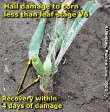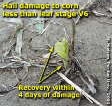These images were taken on 22 May 2000, four days after a severe hail storm in Clinton County, Indiana. The leaf stage at the time the storm hit was V4 to V5 (four to five visible leaf collars). Air temperatures during the four days following the storm were cool and total accumulated GDDs were less than 50.
Extensive leaf shredding occurred on all plants. A small percentage of plants were nearly completely defoliated, i.e., nearly all above-ground leaf material removed. The plants illustrated below are examples of severe defoliation that will nonetheless likely result in surviving plants with little to no yield loss.
After four days, these plants exhibited about one inch of regrowth from the damaged whorl. If temperatures had been more normal (warmer) during the time since the storm, regrowth would have been even more evident.
| Click on image to load larger version. | |
 Image 1 |
 Image 2 |
 Image 3 |
 Image 4 |
 Image 5 |
|
The following image illustrates the range of severity of the hail damage in the field represented by two adjacent plants. The plant with the more severe defoliation, while nasty-looking, may still survive if the growing point is undamaged.
| Click on image to load larger version. | |
 Image 6 |
The final images illustrate one of the uncertainties involved with determining whether a hail-damaged plant will be a survivor or not. Severe damage to the whorl tissue, without actual defoliation, results in a narrow zone of dead leaf tissue. As this tissue dies and dessicates, the narrow zone becomes very restrictive against further expansion of leaf tissue from within the undamaged portion of the whorl beneath it. As with other aspects of assessing hail damage, predicting the ability of such damaged plants to break loose of the restriction is difficult so soon after a storm. Nonetheless, be aware that corn can recover from the type of whorl damage depicted below.
| Click on image to load larger version. | |
 Image 7 |
 Image 8 |